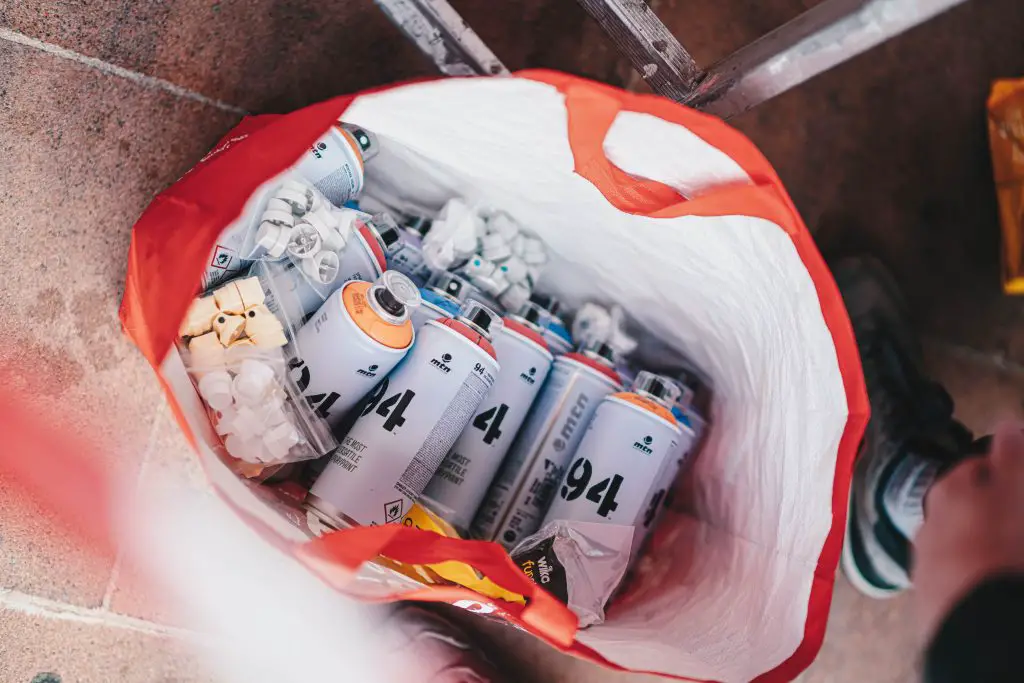Golf driver painting requires a bit of planning but it does not have to be an impossible task.
It’s common for golfers to get bored of their golf clubs and there’s nothing in the USGA rules against painting a golf driver.
If you want to start painting a golf driver at home, you are welcome to do so. However, you will need to know what’s required when painting a driver.
To paint a golf driver, use enamel spray paint or golf club paint. Wipe the golf club with a cloth, cover the working area with plastic, put masking tape on the non-painted areas of the driver, and apply the first coat of paint. Wait a few hours and apply the second paint. Wait another few hours and apply the clear coat spray for protection.
Whether you want to start painting a driver heat matte black or silver, it has to be done by following the steps in this guide.
Spraying painting a driver can be done within a few hours if you go in with a plan.
This comprehensive guide on how to paint a golf driver will show you the ins and outs of driver painting for golfers. This includes spray painting a driver, the best paint for a driver head, and the main steps on how to repaint a golf driver head.
Key Materials For Painting A Golf Driver
It’s best to start with the right materials for golf driver painting projects. Take the time to collect these materials before painting a driver.
These materials include:
- Masking Tape
- Golf Club Paint/Spray Paint
- Clean Cloth
- Clear Coat Spray
- Protective Plastic
- Wrench
Whether you are painting a driver black or silver, you will want to have these materials in place before starting.
Steps For Painting A Driver
1. Clean The Golf Club
Before you paint a golf driver’s head, you will want to take the time to prepare the surface.
How are you going to do this?
You will want to begin by inspecting the golf driver. This is important if you want to know how to repair a golf driver club head’s paint.
Look for scuffs and scratches or spots where the paint has faded. Next, you are going to take a clean cloth and begin to wipe the driver’s head.
When learning how to spray paint a golf driver head, you do want to take these steps into consideration as much as possible.

2. Cover The Working Area With Protective Plastic
Hand-painted golf clubs can be messy projects if you go into the process without a plan.
The best place to start will be the working area.
You are going to want to prep it with the protective plastic you acquired. We recommend taking the protective plastic and spreading it on the floor or the table where you are going to spray paint the golf driver.
It’s best to have a good working area of at least 6 ft x 6 ft to make sure you can use the spray paint on the golf driver head without making a mess.
The spray paint will spread and it needs to be contained with the help of the plastic. Otherwise, you are going to have quite a mess on your hands after the golf club driver painting is done.
3. Cover Every Inch Of The Driver With Masking Tape (Minus The Area Being Painted)
Now, it’s time to prepare the golf driver.
Golf drivers need to be handled with care or the paint is going to get everywhere. This will take away from all of the hard work you are going to do while painting a golf driver head.
So, how do you do this properly?
You are going to take the masking tape and put it on all of the areas where you are not going to be painting. Every inch should be covered by the time you are done minus the driver head.
This is also ideal as it will allow you to focus when painting.
4. Apply The First Coat Of Paint
Now, it’s time to start using the golf driver paint.
Golf driver paints will come in two forms – spray paint or touch-up golf club paint. Depending on how much of the golf driver head you’re painting, the options are going to vary.
For smaller areas of the driver head, you can use the golf club paint fill pens. Otherwise, you will want to use spray paint on the golf club.
The first coat can be done casually. You are going to be looking to cover as much of the area as you can and you will want to be even with how you are spraying the paint on the golf driver head.
Once you are done, you will want to wait 1-2 hours.
5. Apply The Second Coat Of Paint
After the waiting period is done, you will now want to spray paint the driver again.
This time you are going to be more methodical and look to provide an even coat as this is going to be the final coat of paint on the golf driver.
It is the coat everyone is going to see when they look at your golf driver, so take your time with it.
You are again going to wait 1-2 hours for this coat of paint to dry.

6. Apply Clear Coat Spray For Protection
For a good golf driver custom paint job at home, you will want to take the time to use clear coat spray for protection.
This is essential due to how a golf driver is going to be used and the elements it’s going to be exposed to outdoors. If you don’t take the time to apply clear coat spray on a golf driver after painting it, you will start to see blemishes quickly.
Don’t allow this to happen and apply a coat of clear coat spray for added safety.
7. Let The Golf Driver Dry
To complete the driver painting project, it’s time to let the golf driver dry.
How long should you wait?
It’s best to let it sit for 5-6 hours but it might not need that long. This will depend on how the conditions are and where you are putting the golf driver to dry.
If it is going to be set at room temperature then it is best to wait the full 5-6 hours. You can always go back and check how dry the golf driver is throughout the drying phase.
For the most part, the longer you wait, the better it will be.
Tips For Painting A Driver
1. Work In Small Areas
Spray painting golf driver heads can be challenging.
You will want to be methodical with how you approach a project such as this one. This means covering the entire golf driver with masking tape and then being particular with how you spray the paint.
You will want to work from one area to the next. Do not start spraying randomly.
Target one area and work from left to right. This will let you spray the paint on the golf club evenly.
It’s easy to start spraying with reckless abandon but that will not work. It is going to lead to unwanted spots on the golf driver’s head.
2. Apply Paint With A Distance Of 5-6 Inches
When painting a driver’s head, you are going to want to not bring the spray paint can too close to the golf driver.
Why is this important?
The spray paint is not going to spread evenly and it’s going to look blotchy. This is the last thing you will want while working so hard on painting a driver’s head.
For painting a golf driver’s head, maintain a distance of 5-6 inches from the club. This will ensure the spray paint is applied evenly while both the first and second coat looks clean.

3. Let The Paint Settle
You do want to take the drying phase seriously.
A lot of people will take their time painting a golf driver’s head and then don’t wait during the drying portion of the project.
This is not a good thing and it should be avoided.
You will want to take the time to let the paint settle. This means giving the drying phase at least 1-2 hours between each coat to let it settle as required.
You might not require the entire 1-2 hours but it’s still best to be patient. You don’t want to have to keep doing touch-ups.
Can You Repaint A Driver?
Yes, you can repaint a driver and it’s common to do so. A golf driver will scuff up and look out of shape as it is used more and more. This is why investing in good golf club paint pens or spray paint is the way to go.
Within a few hours, you can spray paint the golf driver’s head and make sure it looks brand-new again.
How Do You Fix A Scuff On A Driver?
To fix a scuff on a driver, it’s best to use a golf club paint pen. This kit will help clear up the scuff instantly once it’s used. Another option is to simply repaint the scuffed area assuming it is a small spot on the driver head.
Each situation is different and it’s important to assess the scuff on the golf driver before working out a plan.
How Do You Remove Sky Marks From A Golf Driver?
To remove sky marks from a golf driver, start by wiping the surface with a clean cloth. Next, use the golf club paint pen kit to remove the white marks on the golf driver head. This will take a few minutes to complete. A secondary option is to simply repaint the golf driver head with quality spray paint.
Can You Buff Out Scratches On Driver Head?
Yes, you can buff out scratches on a driver head. To do this, clean the surface with a cloth, rub the area with sandpaper (lightly), and apply touch-up paint on the scratched areas. This will help remove the scratches on the golf driver instantly.
Do Scratches On Driver Face Matter?
No, scratches on a driver face do not matter. However, most golfers are passionate about maintaining their golf club’s aesthetic and that’s when the scratches look ungainly. It is also harder to resell golf clubs with scratches.
This is why maintaining the golf clubs with scratches is a must.
Are You Allowed To Paint A Golf Driver?
Yes, you are allowed to paint a golf driver under USGA regulations. It’s acceptable to use touch-up paint kits or spray paint to paint a golf driver. It’s important to note, no additional modifications can be made to the golf driver during the process.
Should You Paint A Driver?
Yes, you should paint a driver. It helps lengthen the golf driver’s lifespan, ensures it is aesthetically pleasing year-round, and also maintains the golf driver’s value on the resale market.
These benefits of painting a golf driver head are more than enough to make you want to go through the process as soon as possible.
Final Thoughts
These are the main steps when painting a driver.
To paint a golf driver head, start by acquiring enamel spray paint or touch-up golf club paint. Next, clean the golf driver head with a cloth, cover the work area with plastic, and then cover the non-painted areas with masking tape. Now, apply the first coat of paint and wait 1-2 hours. Once done, apply a second coat of paint and wait another 1-2 hours. The last step is to apply clear coat spray to protect the golf driver.
Just like the specs of a golf driver, you also want to make sure it looks good. When you grip a golf driver, it should look the part. It’s not just about the golf driver shaft but also the driver head.